Securing rights to water for health, food and income
Since time immemorial, rural societies around the world have reverenced the power of water, representing it often as a female or gender-neutral deity in traditions kept alive today through ritual and myth. Little wonder then that governments and international agencies have come to recognize the vital importance of water for women’s empowerment in rural areas, expressing this in a variety of policies and declarations, which have culminated in Sustainable Development Goal, or SDG, 5 (achieve gender equality and empower women and girls) together with SDG 6 (ensure availability and sustainable management of water and sanitation for all).

Photo: Sharad Maharjan / IWMI
The challenge now is to tap into this source of empowerment more fully, translating commitments on record into tangible benefits for rural women on the ground. This is the focus of a paper presented by Barbara van Koppen at a recent expert group meeting (see report). Van Koppen is a principal researcher with the International Water Management Institute (IWMI), which leads the CGIAR Research Program on Water, Land and Ecosystems (WLE).
Held in preparation for the 62nd session of the UN Commission on the Status of Women, the event addressed “challenges and opportunities in achieving gender equality and the empowerment of rural women and girls.” It was organized in Rome by UN Women, the Food and Agriculture Organization of the United Nations (FAO), the International Fund for Agricultural Development (IFAD) and World Food Program. The IWMI paper was a timely contribution, with an especially pertinent message for the International Day of Rural Women 2017.
“No other natural resource . . . flows through so many different dimensions” of women’s well-being, says van Koppen. As emphasized in a book titled Water is Life, diverse uses of water are key for enabling women and girls in agrarian economies to realize their “rights to health, nutrition, dignity, food, and an adequate standard of living and education.” The availability of the right quantity and quality of water at the right place and time can give rise to upward “virtuous” cycles that lead out of poverty, while the lack of water and exposure to water-related disasters can trigger downward “vicious” cycles.
Rural women and girls are all too often pulled in the latter direction. Although they bear most of the burden to fetch water for domestic use and need irrigation for farming, they lack access to water infrastructure and sanitation, and this deprives them of productive and educational opportunities, while also making them disproportionately vulnerable to droughts and floods. These pressures are compounded by “land and water grabbing,” which mainly benefits extractive industries, while offering only limited employment and destroying the small-scale farming systems on which most rural women depend.

How such developments affect rural women is shaped by political and socio-economic conditions at every level – from labor distribution in households and communities to global events, such as mass migration. There are also broad regional differences – between South Asia and sub-Saharan Africa, for example, where most poor households are concentrated. In the former region, age-old use of the plow has reinforced the relegation of rural women to marginal roles, while this “housewivization” is less pronounced in the latter, with agriculture depending mostly on use of the hoe by both women and men.
Across regions, securing women’s water rights and the ensuing benefits depends largely on norms and rules that govern access to water, typically through water infrastructure and technologies. Outlined briefly below are some of the recommendations Van Koppen offers for change in the development of these vital “channels” of water rights.
The task at hand is not only to boost the numbers of women involved in water interventions but to ensure their participation is meaningful at all stages. As IWMI/WLE research in Nepal and India has demonstrated, civil society organizations can help accomplish this by creating a supportive environment for women’s empowerment. To this end, IWMI/WLE have developed a variety of tools (including a manual titled Participatory Gender Training for Community Groups) to engage communities in critical discussions on gender roles and to mobilize support for women within their own households.
They urge the planners of such projects to pay close attention to the multiple factors (such as caste and local power dynamics) that account for social inequality and often exclude the most marginalized women from benefits. The key to women’s empowerment, they argue, lies in a better understanding of the “web of social relationships that exist within and beyond households and communities.”

